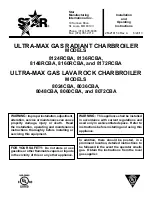
26
5784 566 -10
Vitodens 100-W, B1HA series & B1KA Combi Technical Data
IN THE COMMONWEALTH OF MASSACHUSETTS...
- this product shall be installed by a licensed plumber
or gas fitter.
- the flexible connector (if used) may not exceed 36”.
- any level type shutoff used must be of tee handle type.
Boiler location
As a direct vent appliance, the Vitodens 100-W may
be installed for room air independent operation (sealed
combustion direct vent) regardless of size and ventilation
method of the room in which it is located.
The Vitodens 100-W may be installed, for example, in the
main living area of a house, in non-ventilated utility rooms,
cupboards, closets and alcoves with no clearance required
from combustible materials, as well as in attics with a
direct outlet for the flue gas/fresh air system. Follow all
local and national codes.
Flue gas system
Viessmann coaxial PPS (Polypropylene - flame retardant)
concentric flue gas/fresh air systems and two-pipe
stainless steel/CPVC systems for room air independent
operation (sealed combustion) and side wall venting are
tested to ANSI Z21.13 - CSA 4.9 standards (latest edition)
and are certified together with the Vitodens 100-W boiler
as a constructional unit. The Vitodens 100-W boiler may
also be vented vertically or horizontally, using a metallic
AL29-4C® special stainless steel, or non-metallic CPVC
single-wall, room air dependent venting system (UL/ULC
listed for category IV).
For a more detailed description of the direct vent and
single-wall vent system, please refer to the Vitodens
Venting System Installation Instructions.
Flue gas temperature protection
Viessmann coaxial PPS (Polypropylene - flame retardant)
flue pipes used for the Vitodens 100-W are rated for max.
flue gas temperatures of up to 230°F (110°C).
Flue gas temperature protection is also included although
the maximum permissible flue gas temperature will not
be exceeded in any operating condition or in the event of
malfunctioning.
Low water cut-off
The Vitodens 100 boiler is certified with an internal flow
switch / sensor, however a low water cut-off may be
required by local jurisdiction.
If required, an approved type low water cut-off device
must be provided by the heating contractor.
Do not install an isolation valve between the boiler and the
low water cut-off.
System layout
The max. boiler water temperature for ...
-space heating is 176°F (80°C).
-DHW production is 176°F (80°C).
To minimize distribution losses, Viessmann
recommends that the heating and domestic hot
water systems be based on a maximum boiler
supply temperature of 158°F (70°C).
Due to the low return temperatures
required for gas condensing, avoid the use of mixing
valves in the heating circuit whenever possible.
If mixing valves are required, e.g. for multi-circuit
systems or underfloor heating systems, only 3-way
mixing valves may be used.
Do not use 4-way mixing valves in a system with
condensing
boilers.
Water connections
Vitodens 100-W boilers can be used in any fully pumped
hot water heating system.
Minimum system pressure is 12 psig (0.8 bar).
Chemical corrosion protection products
Corrosion does not typically occur in sealed heating
systems which have been correctly installed and are
correctly operated.
Many manufacturers of plastic pipes recommend the
use of chemical additives. In this case, only commercially
available corrosion protection products that have been
approved for boilers with domestic hot water heating
via single-wall heat exchangers (instantaneous plate
heat exchangers or DHW tanks) may be used.
Underfloor heating systems
For underfloor heating systems Viessmann recommends
the use of plastic tubing with an oxygen diffusion barrier
in order to prevent the diffusion of oxygen through tubing.
If plastic tubing without an oxygen diffusion barrier is used
in underfloor heating systems, Viessmann recommends
that such systems be separated from the boiler with a
heat exchanger.
Water Conditions for DHW B1KA 35, 125
Media: pH value 6.5 to 12, glycol max. 30%
DHW (max. hardness): Chloride up to 250 mg/L
Hardness up to 358 ppm
(= max. 0.278 kg/m
3
lime deposit)
System Design Considerations
Design







































